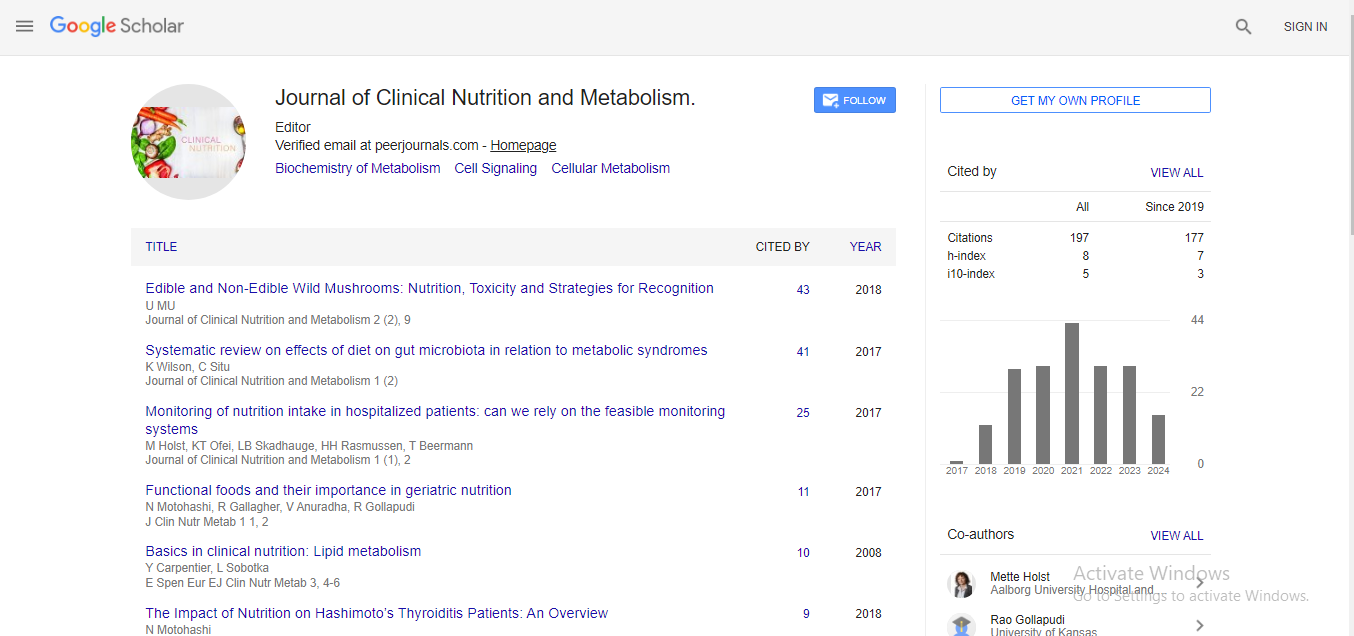Perspective, J Clin Nutr Metab Vol: 5 Issue: 5
Epidemiological and Clinical Studies of Nutrition
Jenkins MN*
National Institute of Standards and Technology, MD 20899, US
- *Corresponding Author:
- Jenkins MN
National Institute of Standards and Technology, MD 20899, USE
E-mail: a.fawzy25@yahoo.com
Received Date: September 06, 2020; Accepted Date: September 06, 2020; Published Date: September 06, 2020
Citation: Jenkins MN (2021) Epidemiological and Clinical Studies of Nutrition. J Clin Nutr Metab 5:5. 127.
Copyright: © All articles published in Journal of Clinical Nutrition and Metabolism are the property of SciTechnol and is protected by copyright laws. Copyright © 2020, SciTechnol, All Rights Reserved.
Perspective
In this review, we briefly summarize some of the key developments in nutritional epidemiology and cancer over the past two decades with a focus on the strengths and limitations of study designs and dietary assessment methods. We present the evidence on dietary fat, meat, fiber, antioxidant nutrients, and calcium in relation to carcinogenesis from large cohort studies and randomized clinical trials (RCTs) and refer to the conclusions of the 2007 World Cancer Research Fund/American Institute for Cancer Research summary report. One prominent theme that emerged is the lack of concordance of results from RCTs and observational studies. There are multiple potential reasons for these discrepancies, including differences in study population, dose and timing of the exposure, adherence to an intervention, length of follow-up, and the primary endpoint. Therefore, null findings of RCTs do not necessarily indicate a lack of effect for the tested dietary factors on cancer risk, as some of these nutrients may have chemo preventive effects if given at the right time and in the right dose. It is likely that potential benefits from diet are due to a combination of food constituents rather than single components acting in isolation. Future efforts need to recognize the integrative nature of dietary exposures and attempt to study nutrients in the larger context of the foods and diets in which they are consumed.Nutritional epidemiology could be regarded as a sub discipline of epidemiology, which provides a specific expertise that is also an integral part of nutritional sciences. As a sub discipline of epidemiology, the overall definition of epidemiology will also hold for nutritional epidemiology. The scientific discipline of epidemiology is defined according to one of the grandfathers of this discipline in the 1970s, Abraham Lilienfeld, in his book ‘Foundations of Epidemiology’ as follows: The study of the distribution of a disease or a physiological condition in human populations and of the factors which influence this distribution. Regarding to this definition, nutritional epidemiology is dealing with nutritional exposures and their roles for the occurrence of diseases and impaired health conditions. The assessment of these exposures and the proper investigation of the link between exposure and end points form therefore the core activities of nutritional epidemiology.
The establishment of the relations between dietary exposures and fully established diseases, non-clinical intermediate end points and impaired health conditions are important information that also constitute the scientific knowledge of nutritional sciences. Many disciplines contribute with their approaches and specific knowledge to this scientific field. The field of nutritional epidemiology has evolved since the 1980s from a small specialty towards a major contributor to science. Nowadays, study results from the many epidemiological studies with dietary data including cross-sectional nutritional surveys form a large body of publications of this journal. Likewise, in other nutritional journals original publications in the area of nutritional epidemiology also form a large part of the articles. Together with molecular nutrition, physiology, toxicology and nutritional medicine, nutritional epidemiology can be considered as a major sub discipline of nutritional sciences. Public Health Nutrition further represents the discipline that converts this knowledge into practice.For the regular readers of scientific journals with interest in diet and nutrition, it is not easy to follow all the articles dealing with the relation between nutritional exposures and health risks. Many nutritional epidemiological articles address questions that are specific for end points ordered according to medical subjects such as endocrinology, cardiology and oncology. However, all of this more subject-related original research uses the research concepts that form the basis of nutritional epidemiology. This includes the areas of dietary assessment, description of nutritional exposure and statistical modeling of the diet-disease relationship. Some of them can be considered as unique contributions to nutritional sciences and medical research.In nutritional epidemiology substantial progress has been achieved over the last years. Compared with the practice in nutritional epidemiology during the 1990s and the first 10 years of the new century, new approaches are gaining grounds. It seems as if a change of paradigm in how to conduct nutritional epidemiological studies, will take place in the near future.Therefore, these new developments are described regarding the basis of nutritional epidemiology with the aim to improve the manuscripts in this area for the future. These new developments can often only be understood in the context of the historical background.
 Spanish
Spanish  Chinese
Chinese  Russian
Russian  German
German  French
French  Japanese
Japanese  Portuguese
Portuguese  Hindi
Hindi 